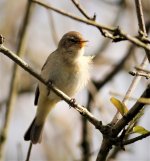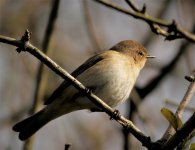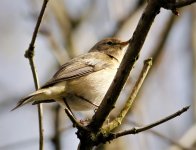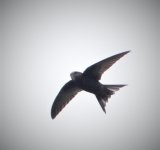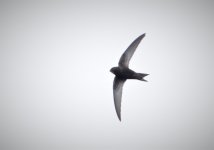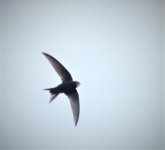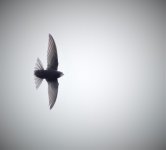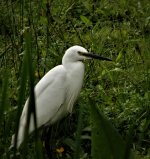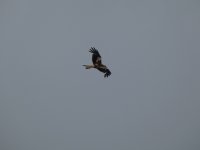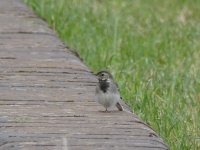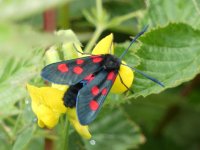keithr
Relapsus resurgam
The end of 2019 provides a chance to reflect upon what has been an enjoyable year of birding on the local patch. I managed to see 143 of the 147 species recorded, and took my fledgling patch list from 126 to 149. The yearly total is including Feral Pigeon, Red-Legged Partridge, Barnacle Goose, Pink-Footed Goose and Egyptian Goose (of which the authenticity is debatable), and excludes Greenland Wheatear, White Wagtail, and Hooded Merganser.
January: 84 Species (0 - 84)
On Jan 1st, a Goldeneye and Mandarin were new-in on Lower Bittell, c80 Golden Plover flew around on the Upper Bittell, and the overwintering Stonechat pair were still present. This was followed nicely on the 4th by a Brent Goose and a Pink-Footed Goose, as well as another Golden Plover. Jack Snipe were frequent all month, with highs of 4/5 individuals. Yellow-Legged Gulls were common, whilst large BHG flocks attracted a few Common Gulls, with Mediterranean Gulls on the 7th and the 9th. A drake Common Scoter visited the Mill Shrub Pool briefly on the 25th, and a female Pintail hung around the area.
February: 82 Species (84 - 90)
A cold and dull start to the month meant a Green Sandpiper on the 3rd was the only new species for some time. The female Pintail remained, multiple Jack Snipe were still present, and the Stonechat pair were joined by other males moving through and searching for territories. A single Golden Plover went through on the 24th. High temperatures at the end of the month triggered a movement of species historically encountered here in March, such as a Curlew on the 23rd, 2 Shelduck on the 25th, and an early flock of Sand Martin on the 28th – all year ticks.
March: 88 Species (90 - 105)
The beginning of March saw the first passage waders arrive, with a Ringed Plover on the 1st, a Dunlin on the 3rd, and a Redshank on the 4th. 4 Pintail were present on March 5th, a Curlew went through on the 8th, and 2 Kittiwakes were found on the 9th and the 11th. On the 17th, another Redshank was joined by the first 4 Little-Ringed Plovers of the year, accompanied by the first Oystercatcher on the 18th. An Osprey went through on the 23rd, and on the 24th a 1W Caspian Gull arrived, showing well into April. On the 30th a Curlew, 2 Shelduck and 7 Goosander were new in, and a Woodcock was reported around this time too. Red Kite sightings were numerous as birds moved from wintering to breeding grounds.
April: 104 Species (105 - 130)
The first Wheatear and GBBG of the year were recorded on the 1st, and a drake Red-Crested Pochard turned up on the 7th. A drake Garganey was present on the 10th, as was a male Redstart and a brief ‘fly-through’ Ring Ouzel. The 11th saw 2 Avocet drop in overnight. Lesser Whitethroat was first seen on the 17th, and the 18th held the first Greenshank of the year. A male Brambling was also seen around this time. The 19th saw the first Whinchat and Reed Warbler of the year move through, whilst Yellow Wagtails and Wheatears became increasingly numerous. A Sandwich Tern was seen briefly on the 20th, with a Sedge Warbler & Stonechat were seen on the 21st alongside a further 3 Whinchat. An Osprey went over on the 22nd, and on the 23rd a summer plumaged Bar-Tailed Godwit dropped in at midday. Hobbies returned on the 27th, as did Garden Warblers, and a Cuckoo was seen on the 30th.
May: 100 Species (130 - 141)
May – what a month! An Osprey was seen on May 2nd, as was a Greenshank that stayed for 10 days. May 7th saw 8 Common Scoters and 5 Black Terns turn up, a taste of what was to come over the next few days. On the 8th, in easterlies and showers, 5 Knot, 1 Great White Egret, 1 Arctic Tern, 1 Black Tern, 4 Greenshank, 3 Redshank, c25 Dunlin and 3 Ringed Plover passed through the site, and the 9th provided a Turnstone, 5 Ringed Plover and a male Whinchat. May 10th provided yet another Knot and Black Tern, as well as a brief Marsh Harrier that ended up at WMBC Ladywalk. On the 11th, a redhead Red-Breasted Merganser joined the second Turnstone of the year, and on the 16th 2 Black Tern and a Greenshank dropped in. The sites first ever Common Crane was found on the 18th, staying for 5 days, and on the 23rd a male Black Redstart and drake Garganey were present. Waders continued to move through as migration tapered off, with 10 Ringed Plover on the 21st, 11 Black-Tailed Godwit on the 24th, and 3 Sanderling on the 31st, supported by a showy male Cuckoo that concluded the month nicely.
June: 84 Species (141)
June – what a comedown! Famous for being a quiet time within the birding calendar, the month was fairly unspectacular. Attentions turned to breeding birds, where notable success was discovered amongst Reed Warbler, Garden Warbler and Little Egret. However, passage had not died completely. Waders still moved through the site, with 2 Ringed Plover on the 4th, 8 Dunlin through on the 8th, a Redshank on the 18th, a Green Sandpiper on the 24th and Common Sandpipers all month, whilst groups of post-breeding Lapwings returned to the shores. Passerine movement was represented by a Yellow Wagtail on the 16th, and a Lesser Whitethroat on the 24th. Wildfowl diversity was surprisingly high, with Mandarin, Teal, Pochard, Gadwall and Shoveler all present at times. Sightings of Hobby were regular.
July: 86 Species (141)
A pair of Black-Tailed Godwits on the 2nd were the first notable waders since the spring. The discovery of at least 6 Red-veined Darters on the 5th was an added bonus. The first Yellow-legged Gull of the ‘autumn’ returned on the 6th, remaining all month. A further 4 Black-Tailed Godwits were present on the 9th, alongside a Dunlin, Redshank and Green Sandpiper. An adult Mediterranean Gull dropped in briefly on the 10th, and another 3 Black-Tailed Godwits turned up on the 16th. However, more remarkably, the immature male Common Crane from earlier in the year made a return on the 16th, staying for a couple of days before continuing its tour of the UK. 5 Common Scoter flew through on the 28th as part of a regional influx, and a juvenile Mediterranean Gull was present briefly on the 30th.
August: 89 Species (141-143)
As the prelude to the peak return passage in September, August offered erratic moments of superb migration action on the patch. The month got off to a good start on the 2nd, with an Avocet, the first ever August Goldeneye, and the first ever Lesser Emperor Dragonfly. A handful of Wheatear were present over the month, with the first returning bird found on the 8th. A juvenile Arctic Tern was found on the 12th, joined by a Wood Sandpiper and Spotted Flycatcher the following day. A Black Tern was picked up on the 18th, however westerly winds meant that passage was still in its infancy across the Midlands. This was until a brief spell of Easterlies seemed to stimulate some movement, with a Marsh Harrier, Wood Sandpiper, Greenshank and Yellow Wagtail on the 23rd, and a remarkable further 13 Greenshank on the 25th. Single Ringed Plovers on the 26th and 28th were the highlights of the next few days. Concluding the month were the second sightings of both Great White Egret and Spotted Flycatcher for the year on the 31st, as well as the first returning Pintail.
September: 86 Species (143)
A combination of westerly winds and an unfavourable shoreline meant that the month got off to a quiet start, with 1 Wheatear and a handful of Yellow Wagtail’s the best of it. However, this was boosted by an Osprey on the 7th, alongside a Wheatear, Dunlin and 3 Spotted Flycatchers; all new in, and all useful additions to the ‘West Midlands All Dayer’, although the Stonechat found on the 8th would have been useful too. What was presumably the same Great White Egret from Aug 31st returned on the 9th, and the highlight of the 11th was a female Redstart, only the 2nd record of the year. From here on, the month was largely quiet. High water levels, shooting of Cormorants, flailing of hedgerows and poor winds all playing their part.
October: (143)
A quiet first week kept up the theme of September, with a Stonechat being the only bird of note. Possible sightings of Merlin, Whooper Swan and 2 White Stork (distant and brief sightings) kept birders on their toes leading into the second week of October, but the lack of confirmed interest was very apparent. On the 12th a decent gull roost formed entailing 2 Mediterranean Gulls (1W), 2 Common Gulls, and 2 Yellow-Legged Gulls. A Ring Ouzel was found on the 17th, the second record of this patch rarity for the year, and a fantastic record at that. On the 19th a Great-White Egret was seen, and on the 21st a vis-mig produced a Golden Plover and a Brambling, whilst another Mediterranean Gull was found on the 28th, a 2W this time.
November: (143-145)
The month started strong on the 2nd, with an adult Little Gull, 3 Goldeneye and a Great-White Egret on Upper, whilst the 4th followed suit with a Cetti’s Warbler on Lower Bittell, and my first Lesser Redpoll of the year, at long last. The Great-White Egret was again present on the 5th, no doubt a lingering bird over the last couple of months. A Woodcock on the morning of the 13th was only the second sighting of the year, as was a Drake Red-Crested Pochard on Lower Bittell on the 17th, which remained present at the months end. On the 22nd, a sighting of two Great-White Egrets was the first multiple count in the site’s history, whilst 2 Mandarin’s were also present. The second Little Gull of the month was found on the 24th during a brief influx into the county. Other notable Gulls were present in the roost at various times during the second half of the month, most notably, 3 Caspian Gulls (two 2W and one Ad) and a GBBG.
December: 145-147
With a seriously quiet first half of the month, a female Goldeneye on the 14th was the only bird of any interest. However, on the 19th, an Egyptian Goose was present on Upper Bittell, alongside a stunning (and seemingly scarce) drake Goldeneye and female Pintail. Better still, an adult Black-necked Grebe turned up on the 20th - the first for the county in 2019. The highest site total of Pochard for a meaningful number of years gathered on the 22nd, with 68 individuals, whilst 5 Shelduck were also new in and notable for the month. An adult Mediterranean Gull was present on the last day of the year.
Conclusion:
When looking back, it’s safe to say we had a pretty good year here. I’d probably say that the bird of the year was the Common Crane, with personal highlights being the finding of Black Redstart and Black-necked Grebe. Omissions from my personal year list were Sandwich Tern, Woodcock, Brambling and Ring Ouzel. Having a shoreline over the spring was great fun, with 20 species of wader racked up in total. On a side note, great fun was had competing in the ‘patch birding’ Midlands league. The healthy competition (mainly with Patch Hopcroft and Andy Pitt) certainly gave me the drive to go and find birds that I wouldn’t have otherwise seen. Congrats to Patch for finishing top of the county at Grimley, leapfrogging me on the penultimate day with a Green-winged Teal!! Happy new year to all – may it be filled with birds and good health!
Congratulations on the brilliant year total and thanks for the detailed report. Great to know the place is still managing to attract species of all forms.
I have not been able to pop in as I used to but was very glad to see the Crane on several days. Some naughty person must have let the Crane out the bag.




